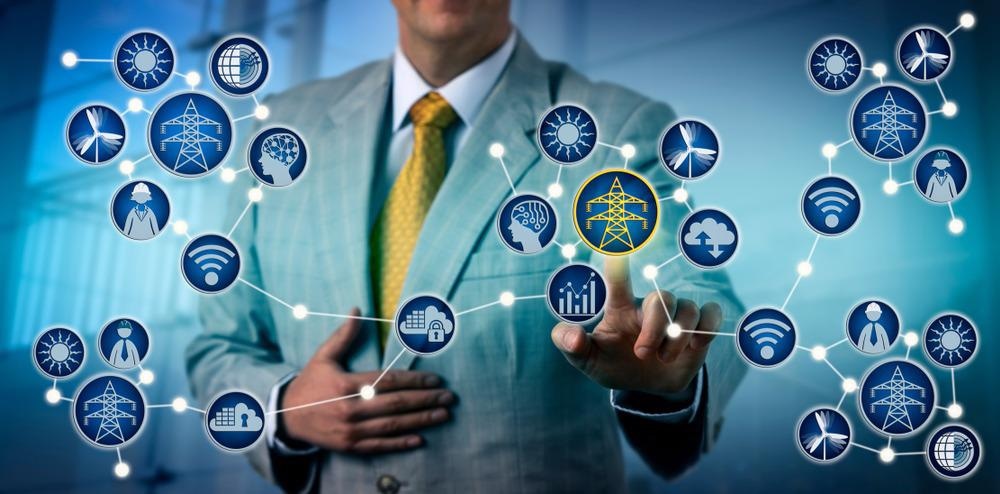Technology company Heila Technologies recently introduced a modular energy platform that enables microgrids to automatically manage themselves. The end-to-end management system, Heila EDGE, connects solar arrays, batteries, and other resources in distributed energy systems and puts them to work to optimize themselves and the network that they make up.

Image Credit: LeoWolfert/Shutterstock.com
The modular energy platform makes components in the microgrid network (comprising energy capture, transfer, storage, and distribution) “smart.” This means each node in the network can “think” (they can process computing tasks with in-built microchips) and “talk” with other nodes (they can transfer data through the internet).
Heila utilizes emergent intelligence algorithms to process all the data generated from the network, optimize the network’s numerous connected functions, and update components with their new commands.
Through the modular energy platform developed by Heila, the entire network is working as one connected organism to maximize efficiencies and control dynamic energy supply. The system manages itself with minimal supervision and can provide a blueprint for a future of optimized energy supply that is as efficient (and sustainable) as possible.
Self-Managing Microgrids
A microgrid is a network of loads and distributed energy resources that interacts with the main grid as a single controllable unit. Microgrids can connect to the grid or disconnect to operate in island mode.
Distributed energy resources (DERs) such as generators, controllable power loads, and storage devices can all be included within a microgrid’s network. Microgrids need to be controlled in some way to manage energy balance in the system in island mode, as well as managing when and how to reconnect to the main grid.
The future viability of the microgrid market relies on digital controllers that perform well. Digital controllers need to manage DERs effectively to achieve resilience in the network, maximize efficiency and reduce energy loss, use as much clean energy as possible, and save costs.
Several approaches have come forward so far. Top-down command-and-control schemes modeled after legacy grid management systems are used, but so are some modern decentralized approaches utilizing information technology and network science to make the whole system work together. Heila’s modular energy platform is an example of the latter.
Other approaches between the two extremes of total top-down control and a decentralized network also exist. Some hybrid digital control techniques have been put forward that seek to incorporate strengths from both approaches. Migrating control functions to cloud computing has also been put forward, although this poses obvious risks to the security and integrity of critical utility systems.
Self-management techniques can be top-down or decentralized. In either case, computing “thought” is highly suitable for the kinds of problems posed by grid management and optimization. Calculating many known variables, processing streams of data that influence those variables in real-time, finding numerically optimal combinations of settings for large numbers of components, and learning from the input/output data of all parts of the system to continually improve processes: computers’ binary decision-making is ideally suited for these kinds of task.
Changing the Way We Manage Microgrids
With Heila’s decentralized modular energy platform for microgrid management, the industry is shifting away from the legacy top-down control systems inherited from its pre-digital era predecessors. This shift may be seen as a response to several different factors in the energy and microgrid sectors.
Grids and microgrids have always had to deal with varying loads to balance the system and ensure no surges or cuts in power result in an outage. But this is made especially difficult in sustainable electric grids supplied by variable renewable energy (VRE). Solar and wind power cannot be planned and supplied consistently to the grid in the same way as nuclear or coal power can.
Microgrids often include more diverse DER assets including various battery chemistries in the same network. Multiple supply-side resources such as different types of renewable energy capture, and different storage solutions, including batteries and hydrogen, also add complexity to the task of a digital controller.
Against these backdrops, decentralized control systems using emergent network intelligence are rising to the fore for microgrid self-management.
How Does Heila EDGE Work?
The Heila EDGE comprises Heila hardware for a protocol gateway, an aggregator, and a distributed controller; Heila software providing the AI and human control and monitoring; and business planning support. The product can be scaled with rising demand as it is modular and adaptive.
Heila EDGE links all the DERs in the system up so that they work together as one independent artificially intelligent organism. The platform uses advanced AI and game theory to make intelligence in each node work as one network.
The result of this connectivity is a network that may be better equipped to deal with the changing supply and demand introduced by VRE. It could also be better at optimizing processes to ensure the whole system is running as efficiently as possible.
References and Further Reading
Guidehouse Insights (2021) Building the Business Case for Decentralized Control Architectures for Microgrids. [Online] Heila Technologies. Available at: https://heilatech.com/stone-edge-whitepaper/
HEILA EDGE: A Modular Energy Platform. [Online] Heila Technologies. Available at: https://heilatech.com/
Microgrid Controls. [Online] NREL. Available at: https://www.nrel.gov/grid/microgrid-controls.html.
Disclaimer: The views expressed here are those of the author expressed in their private capacity and do not necessarily represent the views of AZoM.com Limited T/A AZoNetwork the owner and operator of this website. This disclaimer forms part of the Terms and conditions of use of this website.